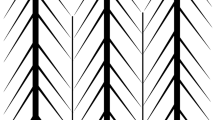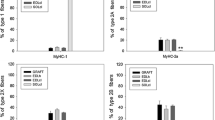Summary
The fine structural development of Golgi tendon organs (GTOs) was studied in leg muscles of the rat from day 18 gestation until 2 months after birth. Small axons were found at the aponeuroses on day 18, but GTOs were first identified on day 20–21 gestation. Prenatally, they appear as discrete islets in the aponeurosis in which a single Ib axon branches and terminates among fibroblasts, collagen bundles and on myotubes inserting into the tendinous tissue.
The receptor body is formed during week 1 postnatal as a result of several concurrent processes: (1) New terminals arise and form numerous contacts with 5–9 myotubes inserting into the GTO area. The innervated myotube tips gradually recede from the aponeurosis. (2) Schwann cells and fibroblasts proliferate and form longitudinal strands adjoining the receding myotubes and converging towards the attachment to the aponeurosis. (3) Axonal branches ensheathed by Schwann cells form terminal enlargements and small-sized terminals. Terminal enlargements are predominantly filled with mitochondria, whereas their peripheral projections and small-sized terminals mainly contain clear and dense core vesicles. (4) Concomitantly collagen fibrils assemble between Schwann cell processes and the developing terminals, and interconnect with collagen bundles, linking the muscle fibre tips to the aponeurosis. Thus collagen bundles of the GTO, which eventually spiral around the terminals and bring about their depolarization when stretched, are formed concurrently with the developing terminals. (5) The GTO becomes encapsulated from day 2 postnatal onwards. (6) Axon terminals loosen their contacts with muscle fibres and are only found among collagen bundles of the receptor from day 5 postnatal onwards. (7) Muscle-fibre tips recede from the GTO lumen by day 7 after birth.
Subsequently, the GTO grows further in length, acquires its fusiform shape by tightening of the capsule at both poles, and becomes structurally mature 2–3 weeks after birth.
The Ib sensory axon together with Schwann cells appear to be the main formative agents in the GTO development, the Ib terminals presumably inducing the retraction of myotubes from the aponeurosis, and the Schwann cells affecting the assembly of collagen fibrils and bundles surrounding the terminals.
Similar content being viewed by others
References
Alnaes, E. (1967) Static and dynamic properties of Golgi tendon organs in the anterior tibial and soleus muscles of the cat.Acta Physiologien Scandinavica 70, 176–87.
Alvarado-Mallart, R. M. andPinćon-Raymond, M. (1976) Nerve endings on the intramuscular tendons of cat extraocular muscles.Neuroscience Letters 2, 121–6.
Barker, D. (1962) The structure and distribution of muscle receptors. InSymposium on Muscle Receptors (edited byBarker, D.), pp. 227–40. Hong Kong: Hong Kong University Press.
Barker, D. (1974) Morphology of muscle receptors. InHandbook of Sensory Physiology, III, Pt. 2., Muscle Receptors (edited byHunt, C. C.), pp. 1–190. Berlin: Springer-Verlag.
Bennett, M. R. andPettigrew, A. G. (1974) The formation of synapses in striated muscle during development.Journal of Physiology 241, 515–45.
Bridgman, C. F. (1968) The structure of tendon organs in the cat: a proposed mechanism for responding to muscle tension.Anatomical Record 162, 209–20.
Bridgman, C. F. (1970) Comparison in structure of tendon organs in the rat, cat and man.Journal of Comparative Neurology 138, 369–72.
Brown, M. C., Jansen, J. K. S. andVan Essen, D. (1975) A large-scale reduction in motoneurone peripheral fields during postnatal development in the rat.Acta Physiologica Scandinavica 95, 3–4A.
Church, R. L., Panzer, M. L. andPfeiffer, S. E. (1973) Collagen and procollagen production by a clonal line of Schwann cells.Proceedings of the National Academy of Sciences U.S.A. 70, 1943–6.
Cooper, S. andDaniel, P. M. (1967) Elastic tissue in muscle spindles of man and the rat.Journal of Physiology 192, 10–11.
Cooper, S. andGladden, M. H. (1974) Elastic fibres and reticulin of mammalian muscle spindles and their functional significance.Quarterly Journal of Experimental Physiology 59, 367–85.
Golgi, C. (1880) Sui nervi nei tendini dell'uomo e di altri vertebrati e di un nuovo organo nervoso terminale musculo-tendineo.Memorie delia Royale Academia delie Scienze di Torino 32, 359–85.
Gray, E. G. (1975) Synaptic fine structure and nuclear, cytoplasmic and extracellular networks. The stereo frameworkconcept.Journal of Neurocytology 4, 315–39.
Greenlee, T. K., Jr. andRoss, R. (1967) The development of the rat flexor digital tendon, a fine structuralstudy.Journal of Ultrastructure Research 18, 354–76.
Guth, L. (1974) ‘Trophic’ functions. InThe Peripheral Nervous System (edited byHubbard, J. I.), pp. 3–26. New York and London: Plenum Press.
Hagbarth, K. E. andWohlfart, G. (1952) The number of muscle-spindles in certain muscles in the cat in relation to the composition of the muscle nerves.Acta Anatomica 15, 85–104.
Hinsey, J. C. (1927) Some observations on the innervation of skeletal muscle of the cat.Journal of Comparative Neurology 44, 87–195.
Hinsey, J. C. (1934) The innervation of skeletal muscle.Physiological Reviews 14, 514–85.
Houk, J. andHenneman, E. (1967) Response of Golgi tendon organs to active contractions of the soleus muscle of the cat.Journal of Neurophysiology 30, 466–81.
Huber, G. C. andDe Witt, L. M. A. (1900) A contribution on the nerve terminations in neurotendinous endorgans.Journal of Comparative Neurology 10, 159–204.
Hunt, C. C. (1974) The physiology of muscle receptors. InHandbook of Sensory Physiology, III, Pt. 2., Muscle Receptors (edited byHunt, C. C.), pp. 191–234. Berlin: Springer-Verlag.
Ilyinsky, O. B. andChalisova, N. I. (1975) Problema obrazovaniya i regeneracii receptorov pozvonochnykh zhivotnykh. Uspekhy sovremennoj biologii80, 441–57 (Moskva).
Jörgensen, J. M. andFlock, A. (1976) Non-innervated sense organs of the lateral line; development in the regenerating tail of the salamanderAmbystoma mexicanum.Journal of Neurocytology 5, 33–41.
Landon, D. N. (1972) The fine structure of the equatorial regions of developing muscle spindles in the rat.Journal of Neurocytology 1, 189–210.
Loewenstein, W. R. (1971) Mechano-electric transduction in the Pacinian corpuscle. Initiation of sensory impulses in mechanoreceptors. InPrinciples of Receptor Physiology (edited byLoewenstein, W. R.), pp. 269–90. Berlin: Springer-Verlag.
Matthews, P. B. C. (1972)Mammalian Muscle Receptors and their Central Actions. London: Edward Arnold.
Merrillees, N. C. R. (1962) Some observations on the fine structure of a Golgi tendon organ of a rat. InSymposium on Muscle Receptors (edited byBarker, D.), pp. 199–206. Hong Kong: Hong Kong University Press.
Milburn, A. (1973) The early development of muscle spindles in therat.Journal of Cell Science 12, 175–95.
Nathaniel, E. J. H. andPease, D. (1963) Collagen and basement membrane formation by Schwann cells during nerve regeneration.Journal of Ultrastructure Research 9, 550–60.
Redfern, P. A. (1970) Neuromuscular transmission in new-bornrats.Journal of Physiology 209, 701–9.
Schoultz, T. W. andSwett, J. E. (1972) The fine structure of the Golgi tendon organ.Journal of Neurocytology 1, 1–26.
Schoultz, T. W. andSwett, J. E. (1974) Ultrastructural organization of sensory fibres innervating the Golgi tendon organ.Anatomical Record 179, 147–62.
Shantha, T. R. andBourne, G. H. (1969) The perineurial epithelium — a new concept.In The Structure and Function of Nervous Tissue, I (edited byBourne, G. H.), pp. 379–459. New York: Academic Press.
Shimizu, M. (1971) Ultrastructure of Golgi's tendon spindle of mouse (In Japanese).The Journal of the Yonago Medical Association 22, 285–96.
Silver, A. (1963) A histochemical investigation of cholinesterases at neuromuscular junctions in mammalian and avianmuscle.Journal of Physiology 169, 386–93.
Sklenská, A. (1973) Die Ultrastruktur des Golgischen Sehnenorgans bei der Katze.Acta Anatomica 86, 205–21.
Speidel, C. C. (1947) Correlated studies of sense organs and nerves of the lateral-line in living frog tadpoles, I. Regeneration of denervated organs.Journal of Comparative Neurology 87, 29–55.
Stone, L. S. (1933) Independence of taste organs with respect to their nerve fibres demonstrated in living salamanders.Proceedings of the Society for Experimental Biology and Medicine (New York) 30, 1256–7.
Stuart, D. G., Goslow, G. E., Mosher, C. G. andReinking, R. M. (1970) Stretch responsiveness of Golgi tendon organs.Experimental Brain Research 10, 463–76.
Stuart, D. G., Mosher, C. G., Gerlach, R. L. andReinking, R. M. (1972) Mechanical arrangement and transducing properties of Golgi tendon organs.Experimental Brain Research 14, 274–92.
Swett, J. E. andEldred, E. (1960) Distribution and numbers of stretch receptors in medial gastrocnemius and soleus muscles of thecat.Anatomical Record 137, 453–60.
Swett, J. E. andSchoultz, T. W. (1975) Mechanical transduction in the Golgi tendon organ: A Hypothesis,Archives Italiennes de Biologie 113, 374–82.
Tello, J. F. (1917) Genesis de las terminaciones nerviosas motrices y sensitivas. I. En el sistema locomotor de los vertebrados superiores. Histogenesis muscular.Trabajos del Laboratorio de investigationesbiolbgicasde la Universidad de Madrid 15, 101–99.
Tello, J. F. (1922) Die Entstehung der motorischen und sensiblen Nervenendingungen.Zeitschrift für Anatomie und Entwicklungsgeschichte 64, 348–440.
Tennyson, V. M. (1970) The fine structure of the axon and growth cone of the dorsal root neuroblast of the rabbit embryo.Journal of Cell Biology 44, 62–79.
Thomas, P. K. (1964) The deposition of collagen in relation to Schwann cell membrane during peripheral nerve regeneration.Journal of Cell Biology 23, 375–82.
Tiegs, O. W. (1953) Innervation of voluntary muscle.Physiological Reviews 33, 90–144.
Webster, H. deF. (1974) Peripheral nerve structure. InThe Peripheral Nervous System (edited byHubbard, J. I.), pp. 3–26. New York: Plenum Press.
Wohlfart, G. andHenriksson, K. G. (1960) Observations on the distribution, number, and innervation of Golgi musculo-tendinous organs.Acta Anatomica 41, 192–204.
Yamada, K. M., Spooner, B. S. andWessels, N. K. (1971) Ultrastructure and function of growth cones and axons of cultured nerve cells.Journal of Cell Biology 49, 614–35.
Zelená, J. (1963) Development of muscle receptors after tenotomy.Physiologia bohemo-slovenica 12, 30–36.
Zelená, J. (1964) Development, degeneration and regeneration of receptor organs.Progress in Brain Research 13, 175–211.
Zelená, J. (1975) The role of sensory innervation in the development of mechanoreceptors. InSomatosensory and Visceral Receptor Mechanisms (edited byIggo, A. andIlyinsky, O. B.), pp. 59–64. Amsterdam: Elsevier.
Zelená, J. (1976) Sensory terminals on extrafusal muscle fibres in myotendinous regions of developing rat muscles.Journal of Neurocytology 5, 447–63.
Author information
Authors and Affiliations
Rights and permissions
About this article
Cite this article
Zelená, J., Soukup, T. The development of Golgi tendon organs. J Neurocytol 6, 171–194 (1977). https://doi.org/10.1007/BF01261504
Received:
Revised:
Accepted:
Issue Date:
DOI: https://doi.org/10.1007/BF01261504




